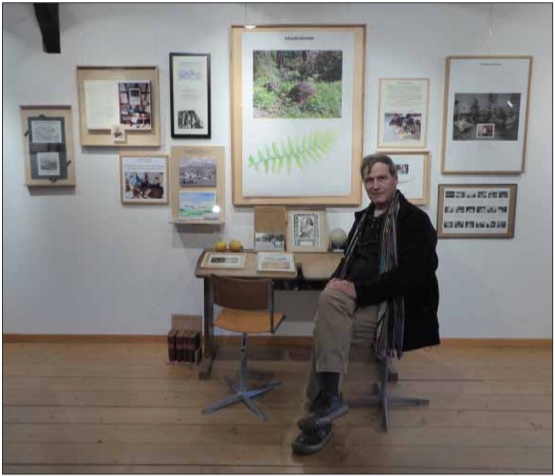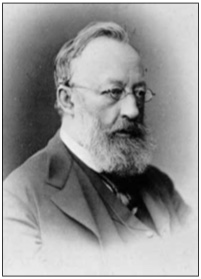Democracy, culture and peace ethics

In the light-filled gallery in the attic of a spacious traditional house, Gottfried Keller has taken a place of honour. Today, it is the Gottfried-Keller-Zentrum, located in the middle of the wine-growing village of Glattfelden (Zurich Unterland). The central installation dedicated to him is framed by works of art dedicated to eleven other related writers. The light personalities range from Johann Heinrich Pestalozzi, Goethe and Schiller through Henry Dunant, Leo Tolstoy, Albert Schweitzer, Bertha von Suttner and Romain Rolland to Meinrad Inglin, Albert Camus and Chyngyz Aitmatov. The atmospheric gallery has thus been transformed into a complete art work which, in the pictorial language of the Zurich conceptual artist Urs Knoblauch, draws a large intellectual-historical arc. Paintings, sometimes large-scale, sometimes detail-oriented, are decorated with photographs, symbolic objects and texts on walls and niches to form entire installations. All works are provided with meaningful quotations, sometimes graphically designed, often incorporated into the paintings themselves in the artist’s handwriting.
Assembly of humanistic spirits
On the occasion of his 200th birthday, the exhibition with works by Urs Knoblauch honours the great realist Gottfried Keller. It emphasises the intellectual roots of the world-renowned Swiss writer. These are anchored in the global humanist tradition of thought, which places the human being at the centre and awards him value and dignity because he is a human being. Urs Knoblauch illustrates this with his own artistic means: Gottfried Keller’s realism is based in its essence on morality and social responsibility. He is characterised by his commitment to man, his dignity, his freedom and his claim to lead a life in peace and honest exchange. This concern and the struggle for it he shares with the other writers present in the room. His peculiarity is that he also grasped this basic attitude politically – he considers it as indispensable for the success of modern democracy, if deserving this name, concretised in modern Swiss democracy, which he not only praises, but also measures over and again by its own standard.
50 years of the concept of “Capturing more precisely”
Urs Knoblauch was born and raised in Zurich. First, the artist underwent a creative training and received an art scholarship from the City of Zurich. After graduating as a secondary school teacher, he worked as a drawing teacher at the “Literargymnasium Rämibühl” in Zurich until he retired. In addition to his artistic activities and his permanent publications as a cultural journalist, he also gave generations of young people the pleasure of drawing and painting, sharpening their view of the world. As a member of the “Maturitätskommission” of the Canton of Schwyz, the enthusiastic and inspiring teacher continues to be associated with the school. As an artist committed to his own concept “GENAUER ERFASSEN” (capturing more precisely), which he has pursued for 50 years, Urs Knoblauch is regularly present at exhibitions and site- and space-related works in Switzerland and abroad. His ethical, humanistic and cultural-historical themes are in dialogue with painting, photography and text. Together with his wife Lene, the conceptual artist lives and works today in his studio house in Fruthwilen, Thurgau, high above the Untersee (Lake Constance).
Ethics of culture and peace
Urs Knoblauch presents his exhibition under the title “Ethics of Culture and Peace”. It has the significant subtitle “Zum sittlichen und sozialen Realismus in der Literatur- und Kulturgeschichte – Wirken für das Individual- und Gemeinwohl” (On moral and social realism in the history of literature and culture – working for the individual and the common good). As in previous exhibitions, Urs Knoblauch ties the pictorial-textual messages to human culture. The conceptual artist attaches great importance to the responsibility of the artist in particular for ensuring that our culture remains true culture, i.e. humane. When visiting the exhibition, the observer encounters personalities in every detail who see man in interaction with his fellow human beings and his social environment. For Urs Knoblauch, genuine realism is closely linked to the ethic of peace, which develops essentially from the individual’s sense of responsibility for the whole, the bonum commune.


Central installation on Gottfried Keller
The central installation dedicated to Gott-fried Keller is built around an old school desk.
It is reminiscent of Gottfried Keller’s own struggle for education and how centrally it was tied back for this writer to the foundations of a living democracy. Democracy in its very own form was and is only possible if it is linked to the ethical foundation. For Gottfried Keller, a solid school education that, according to Pestalozzi, includes the forces of the mind, physical and manual dexterity as well as the forces of the mind, is one of the basic prerequisites for this. Only in this way can the demanding path of a democracy succeed, supported and co-responsible by the citizens themselves, as it has taken on a valid form in the Swiss Federal Constitution of 1848.
From painter to writer
The later writer and constructive-critical Swiss patriot comes from a middle-class family. Gottfried Keller’s father was a publicly active craftsman, his mother the daughter of a country doctor and district judge. Both came from Glattfelden, where the young writer-to-be spent long and formative stays in the home of his uncle. The path to becoming a writer was not marked out for the only son of a family in material distress due to the early death of his father. Because of a minor disciplinary offence, the gifted pupil was expelled from secondary school. The path to becoming a writer was not straightforward. At first it led Gottfried Keller through his training as a painter. Keller’s strong talent, however, was not purposefully promoted, so that a stay in Munich dedicated to training as a painter did not produce the desired result. The young Keller now increasingly felt the desire to work as a writer. After his first lyrical attempts, the decision was made on the basis of a further education scholarship provided by the City of Zurich. It led Keller to the University of Heidelberg and then to Berlin, where he finished “Der grüne Heinrich” (Green Henry). After years of intensive self-study, including self-discovery, Keller made his breakthrough as a writer, especially in Novellistics. His two collections of Novellas, “Die Leute von Seldwyla” and the “Züricher Novellen”, made the writer famous not only in Zurich. The immortal stories of people who lose sight of the centre of meaning of life for a time and finally, often in encounters with women strong in life and character, gain a firm foothold in active life, were translated into all cultural languages.
Only the argument counts
Despite his openness to the world, Gott-fried Keller has always seen himself as a Swiss writer. He identified himself with the Swiss Confederation of 1848 as a federal state and expected much from its direct democracy. In a novella of the middle years, “Das Fähnlein der sieben Aufrechten” (The Flag of the Seven Uprights), he distances himself from political radicalism in strong images. For Keller, the argument must permeate the democratic debate, and thereafter the resulting contribution to the whole. In the “Green Henry”, the young hero, who returned home from what was then still monarchist Germany, is fascinated by the everywhere tangible awakening of a rejuvenated Switzerland that is struggling for unity in diversity. What prevails must no longer only follow particular interests, but must be capable of winning a majority. For Keller, this is the most important and only control that democracy needs. In order to actively serve the young Swiss democracy and also as gratitude to a city that with its scholarship supported its son on the way to becoming a writer, Gottfried Keller held the demanding position of First State Secretary of the Canton of Zurich for 15 years after 1855. The position he filled with a great sense of duty so that he did not write any major literary works during this time. In his novel “Martin Salander”, the writer shows in various forms what is dangerous for the noble hunt for majority-capable decisions supported by the citizens.
The demon of the founding years – already history?
Keller sees a major danger for democracy in “Martin Salander” in the unpleasant spirit of arrogance, of wanting to be more than fellow citizens. Although this striving in the novel results entirely from the weakness of the characters described, such democratic misconduct has become almost endemic in Switzerland at the end of the 19th century, Keller emphatically states. The cases of systematic fraud and enrichment committed (also by respected fellow citizens and responsible persons) against the individual, but also against the national wealth, are deeply affecting. They resemble scandals in every detail, which have been generating headlines in today’s Switzerland for years. As in “Fähnlein”, the author focuses on young people. If they grow up healthy, i.e. not spoiled, but encouraged to make their contribution, they are provided with inner protection against all kinds of challenges. Keller’s father was already aware that a good public school must lay down and cultivate this democratic consciousness. At first hand as a pupil, the young Keller did not experience this training of the nation, which was later anchored in the constitution. Hence, it was all the more emphatic in the school of life. •
The exhibition in the “Gottfried-Keller-Zentrum”, Gottfried-Keller-Strasse 8, 8192 Glattfelden, will last until 28 April (14–16 h finissage).
Opening hours: Mon–Fri, 9–11.30 h and 14–17 h, Sat, Sun, 10–15 h
(Translation Current Concerns)